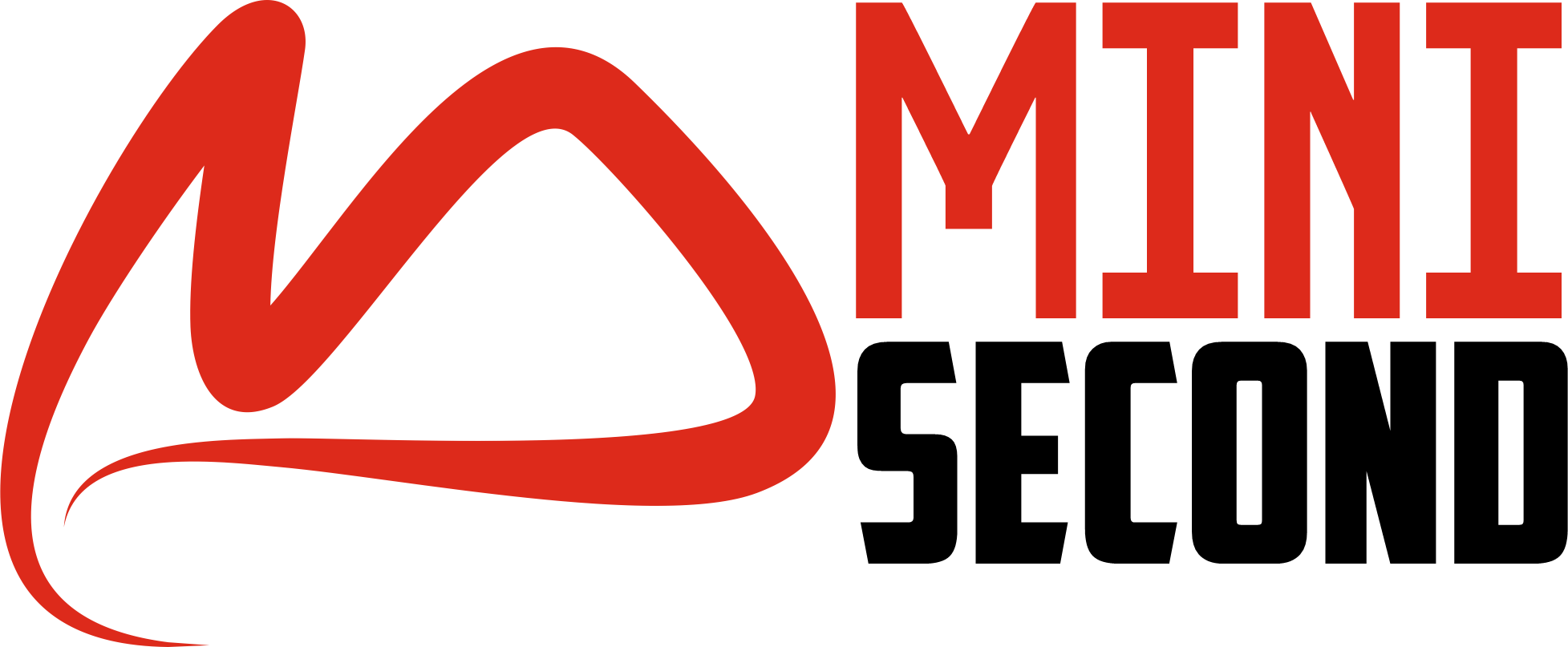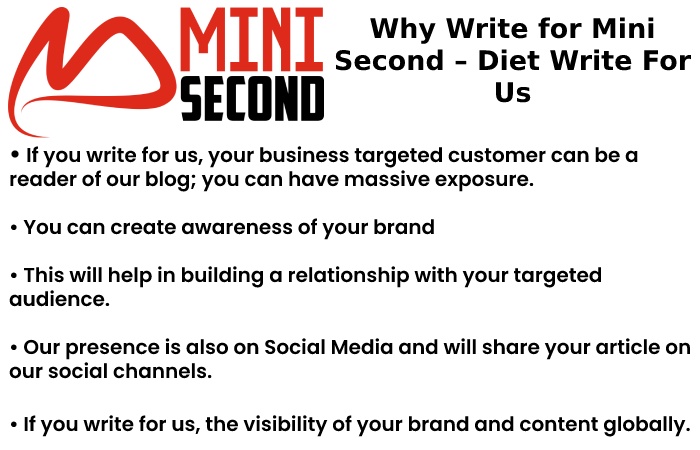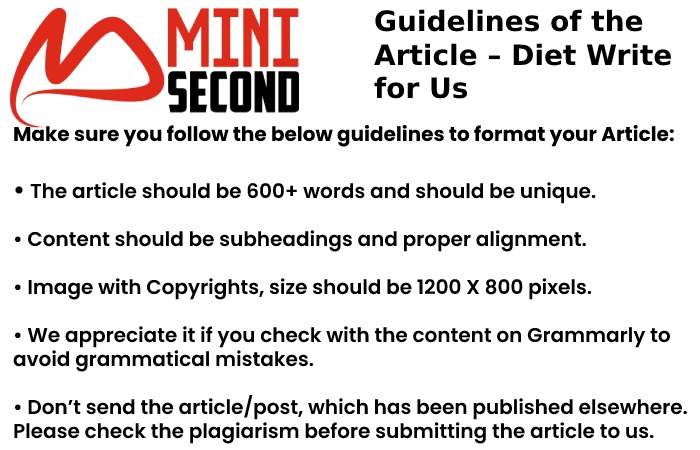Diet Write For Us – The general population is clear that it is convenient to follow a balanced and healthy diet, but it is often difficult to know how to put it into practice.
Various studies have shown that each person’s perception of healthy eating is different; in fact, it varies significantly from region to country or country to country. That is why the health authorities of each country create food education programs adapted to populations to improve the population’s food intake through understandable recommendations that are easy to put into practice.
The dietary guidelines
Among the different intervention strategies, we find the dietary guidelines, which translate the nutritional objectives and recommended nutrient intakes into a language understandable to all, recommending the consumption of food in portions, distinguishing the frequency of consumption (daily, weekly, occasional… ), and forming food groups according to their nutritional similarity. There are different representations in graphic form: the food wheel, consumption frequency tables, and the healthy pyramid…
Diet is constantly evolving, and therefore updates regarding nutritional advice are also reflected in updates to dietary guides, the WHO (World Health Organization), the SENC (Spanish Society of Community Nutrition), and health departments. In addition, the health of the autonomous communities regularly publishes updates to their dietary guides.
What is a balanced diet?
A balanced diet means following a healthy diet, which we can define as a diet that is complete and sufficient (it provides us with all the nutrients we need), adapted to our characteristics (sex, age, height, physical activity…), to the environment, sustainable and affordable—basing the diet mainly on fresh vegetables and fruits, legumes (lentils, chickpeas, beans…), nuts (walnuts, almonds, hazelnuts…), whole grains (bread, rice, pasta…), tubers (potato or sweet potato), oil virgin olive oil, and to a lesser extent fish, simple dairy products, meat, and eggs and avoiding processed foods, rich in fats and sugars.
According to the WHO, having a healthy and balanced diet helps us prevent malnutrition, non-communicable diseases ( diabetes, heart disease, cardiovascular accidents, and cancer), and different conditions.
Foods to avoid:
- Honey and syrups.
- Chocolate and cocoa powder with sugar.
- Margarine and butter.
- Fruit juices.
- Sugary drinks such as soft drinks, packaged juices…
- Sweetened milk and chocolate shake.
- Sweetened yogurts and other sweetened dairy desserts (custards, custard
At lunch and dinner plate method
The Harvard plate or plate method is handy for learning how to create balanced dishes. It is based on visually using the container to distribute the food in the right proportions, allowing different combinations to prepare menus, and ensuring a correct nutritional composition. It is recommended that varied culinary techniques be used throughout the week, in quantities according to the needs of each person, depending on whether they have to lose weight, is an athlete, are a child, adolescent, a pregnant woman…
The visual distribution of the food on the plate will be as follows:
50% vegetables:
- It would be best if you tried to eat them fresh, in season, and locally, as they have a better taste, smell, and nutritional quality. They provide little energy and many vitamins, minerals, and fiber.
25% whole grains and tubers:
- This group includes sweet potatoes, bread, rice, corn, and quinoa… preferably whole grains. Carbohydrates mainly provide energy in addition to vitamins, minerals, and fiber.
25% lean meat, fish, eggs, and legumes
- (chickpeas, beans, lentils, peas…). Excluded for punctual consumption are fatty meats, sausages, cured, smoked… due to their high saturated fat content. Instead, they provide proteins to create and repair the body’s cells and promote optimal bone and muscle growth.
The dish should be accompanied with
water as a drink and fruit or unsweetened natural yogurt for dessert.
One-day diet example
Breakfast:
- Coffee with milk or sugar-free vegetable drink
- Whole wheat bread sandwich with tomato and avocado
Midmorning:
- Natural yogurt with a chopped kiwi and a handful of hazelnuts.
- Glass of water
Food:
- Oak leaf, lamb’s lettuce, and roasted red pepper salad
- Chickpeas with tomato and hard-boiled egg
- a slice of watermelon
Afternoon snack:
- Peach
- Infusion
Dinner:
- broccoli with couscous
- Grilled hake with garlic and parsley
- Apple
The amounts of food will be adapted according to individual needs. The intakes during mid-morning and snacks are excellent times to take those foods we need to cover throughout the day.
What you should know…
- A balanced diet means following a healthy, complete, sufficient diet (it provides all the nutrients we need), adapted to our characteristics (sex, age, height, physical activity…), to the environment, sustainable and affordable.
- The Harvard plate or plate method is a handy tool based on using the scale visually to distribute food in the right proportions and allow correct nutritional composition.
- We must not forget that an active lifestyle and regular physical exercise are essential, along with good eating habits, for good health.
Most common types of diets
We could describe the term diet as those eating habits that constitute our daily diet. The diets vary depending on the person, the tastes or needs of each one. The best-known are:
Hypocaloric
This is a diet that restricts daily caloric intake; that is, calorie consumption is reduced abruptly, providing the body with less energy than recommended. This type of diet is the most common when treating cases of overweight or obesity since it produces visible changes very quickly. However, it is not a reliable diet since it usually has a rebound effect, which means that the results do not last over time, and the patient recovers his previous weight again.
Hypercaloric
diet Contrary to the low-calorie hypocaloric diet, the hypercaloric diet provides a higher energy load than the body needs. It is a diet used primarily by people who want or need to increase their muscle mass.
Detox
The term detox has become popular in recent years. In this case, the detox diet is created to “detoxify” our body from copious meals or excess fat. There are several ways to carry it out: with weekly cleansing shakes that complement the daily diet or by consuming exclusively liquids for at least one day a week. It is a dangerous diet since consuming excess beverages without a food base in our body can cause imbalances in our absorption of vitamins and proteins, which poses a health risk.
Protein
As its name suggests, this diet is based on a much higher protein intake than carbohydrate and lipid intake. It is a low-calorie diet and is quite famous among people who play sports and want to lose weight.
Vegetarian
Diet Finally, the vegetarian diet defends only the consumption of products of vegetable origin, basing the diet on the consumption of legumes, fruits, vegetables, or vegetables, thus eliminating any product of animal origin.
Disadvantages of these types of diets
– They do not last over time
– They have side effects such as loss of energy or lack of vitamins
– Some of them increase the risk of cholesterol or blood glucose
– They can cause irritability, anxiety, loss of muscle mass, dizziness, or tiredness
What is the best type of diet?
A good diet improves and maintains our health. All foods from the food pyramid groups, such as bread, meat, vegetables, fruits, and seeds, must be present, reducing as much as possible foods that provide more calories than energy, such as pastries or drinks, sugary energy.
Therefore, a balanced diet and a small exercise routine of at least 30 minutes daily will help you improve your health, body, and mind.

Likewise, You can submit your articles at contact@minisecond.com
How to Submit Your Diet Write For Us?
That is to say, To submit your article at www.minisecond.com, mail us at contact@minisecond.com.
Why Write for Mini Second – Diet Write For Us
Diet Write For Us
That is to say, here at Mini Second, we publish well-researched, informative, and unique articles. In addition, we also cover reports related to the following:
organism
nutrition
weight-management
omnivores,
vitamins
minerals,
essential amino acids
food energy
quality of life
chemical energy
food
metabolism,
muscular
aerobic respiration
fats


